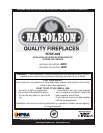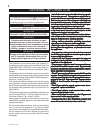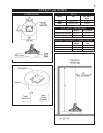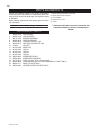Special offers from our partners!

Find Replacement BBQ Parts for 20,308 Models. Repair your BBQ today.

W415-0372 / 02.12.03
9
1. The appliance should be inspected before initial use
and inspected and cleaned at least annually by a qualified
field service person.
2. Tampering is DANGEROUS and voids all warranties.
Any component that is found to be faulty, must be replaced
with an approved component.
3. To obtain proper operation, it is imperative that the burner
flame characteristics are steady, not lifting or floating. Check
the burner flame patterns with the figure below.
4. Periodically remove the logs and examine the burner. If
dirty, clean with a soft brush. Also examine the area around
the burner air shutter. Any dirt or foreign material, such as
spider webs or nests, in this area should be removed.
This will ensure long life and trouble free operation. When
the appliance is put back in service, check the burner flame
patterns with the figure above. Reinstall the logs as shown
in the log placement instructions.
5. Periodically check the hose connecting the LP gas cylin-
der to ensure it is not damaged in any way.
NOTE: Carbon (soot) may build up on the surface of the
logs with heavy use. This is more likely to occur when us-
ing LP gas. The soot should be cleaned off the surface of
the logs periodically to prevent excessive build up. To clean
the logs, be sure the fire is out, the gas supply is turned off
and the logs are cool to the touch. The soot can then be
brushed off with a dry bristle brush or cloth. Take care while
cleaning the logs as they can become damaged if mis-
handled. Care should be taken to dispose of the soot and
cleaning materials properly. Keep away from clothing and
outdoor furniture.
This listed gas appliance is tested and approved for eleva-
tions from 0 to 4500 feet in Canada and the U.S.
When installing this appliance at an elevation above 4500
feet (in the U.S.), it may be necessary to decrease the input
rating by changing the existing burner orifice to a smaller
size. Input should be reduced four percent (4%) for each
1,000 feet above sea level, unless the heating value of the
gas has been reduced, in which case this general rule will
not apply. To identify the proper orifice size, check with the
local gas utility.
When installing this unit at an elevation above 4,500 feet
(in Canada), check with local authorities.
Consult your local gas utility for assistance in determining
the proper orifice for your location.
MAINTENANCE
HIGH ELEVATION INSTALLATION
During the winter months in cold weather climates, it is
recommended to disconnect the Patioflame and store it in
a cool dry place. Do not store the propane tank inside. For
the remainder of the year, protect and cover your Patioflame
from rain, freezing rain and snow.














